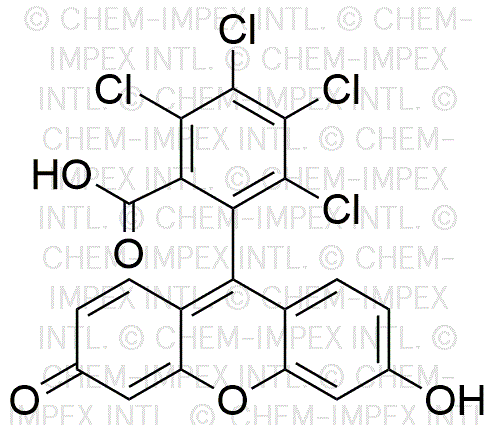3,4,5,6-Tetrachlorofluorescein is widely utilized in research focused on:
- Fluorescent Tracers: This compound is often used as a fluorescent dye in biological and environmental studies, allowing researchers to visualize cellular processes or track pollutants in water systems.
- pH Indicators: Its ability to change fluorescence based on pH levels makes it a valuable tool in titrations and other chemical analyses, providing clear visual cues for researchers.
- Histology and Pathology: In medical research, it serves as a staining agent for tissue samples, helping pathologists identify specific cell types or abnormal growths under a microscope.
- Photodynamic Therapy: The compound has potential applications in medical treatments, particularly in photodynamic therapy for cancer, where it can selectively target and destroy malignant cells when activated by light.
- Environmental Monitoring: Its use in tracking the dispersion of contaminants in aquatic environments helps environmental scientists assess pollution levels and the effectiveness of remediation efforts.
General Information
Properties
Safety and Regulations
Applications
3,4,5,6-Tetrachlorofluorescein is widely utilized in research focused on:
- Fluorescent Tracers: This compound is often used as a fluorescent dye in biological and environmental studies, allowing researchers to visualize cellular processes or track pollutants in water systems.
- pH Indicators: Its ability to change fluorescence based on pH levels makes it a valuable tool in titrations and other chemical analyses, providing clear visual cues for researchers.
- Histology and Pathology: In medical research, it serves as a staining agent for tissue samples, helping pathologists identify specific cell types or abnormal growths under a microscope.
- Photodynamic Therapy: The compound has potential applications in medical treatments, particularly in photodynamic therapy for cancer, where it can selectively target and destroy malignant cells when activated by light.
- Environmental Monitoring: Its use in tracking the dispersion of contaminants in aquatic environments helps environmental scientists assess pollution levels and the effectiveness of remediation efforts.
Documents
Safety Data Sheets (SDS)
The SDS provides comprehensive safety information on handling, storage, and disposal of the product.
Product Specification (PS)
The PS provides a comprehensive breakdown of the product’s properties, including chemical composition, physical state, purity, and storage requirements. It also details acceptable quality ranges and the product's intended applications.
Certificates of Analysis (COA)
Search for Certificates of Analysis (COA) by entering the products Lot Number. Lot and Batch Numbers can be found on a product’s label following the words ‘Lot’ or ‘Batch’.
Numéro de catalogue
Numéro de lot/série
Certificates Of Origin (COO)
This COO confirms the country where the product was manufactured, and also details the materials and components used in it and whether it is derived from natural, synthetic, or other specific sources. This certificate may be required for customs, trade, and regulatory compliance.
Numéro de catalogue
Numéro de lot/série
Safety Data Sheets (SDS)
The SDS provides comprehensive safety information on handling, storage, and disposal of the product.
DownloadProduct Specification (PS)
The PS provides a comprehensive breakdown of the product’s properties, including chemical composition, physical state, purity, and storage requirements. It also details acceptable quality ranges and the product's intended applications.
DownloadCertificates of Analysis (COA)
Search for Certificates of Analysis (COA) by entering the products Lot Number. Lot and Batch Numbers can be found on a product’s label following the words ‘Lot’ or ‘Batch’.
Numéro de catalogue
Numéro de lot/série
Certificates Of Origin (COO)
This COO confirms the country where the product was manufactured, and also details the materials and components used in it and whether it is derived from natural, synthetic, or other specific sources. This certificate may be required for customs, trade, and regulatory compliance.


